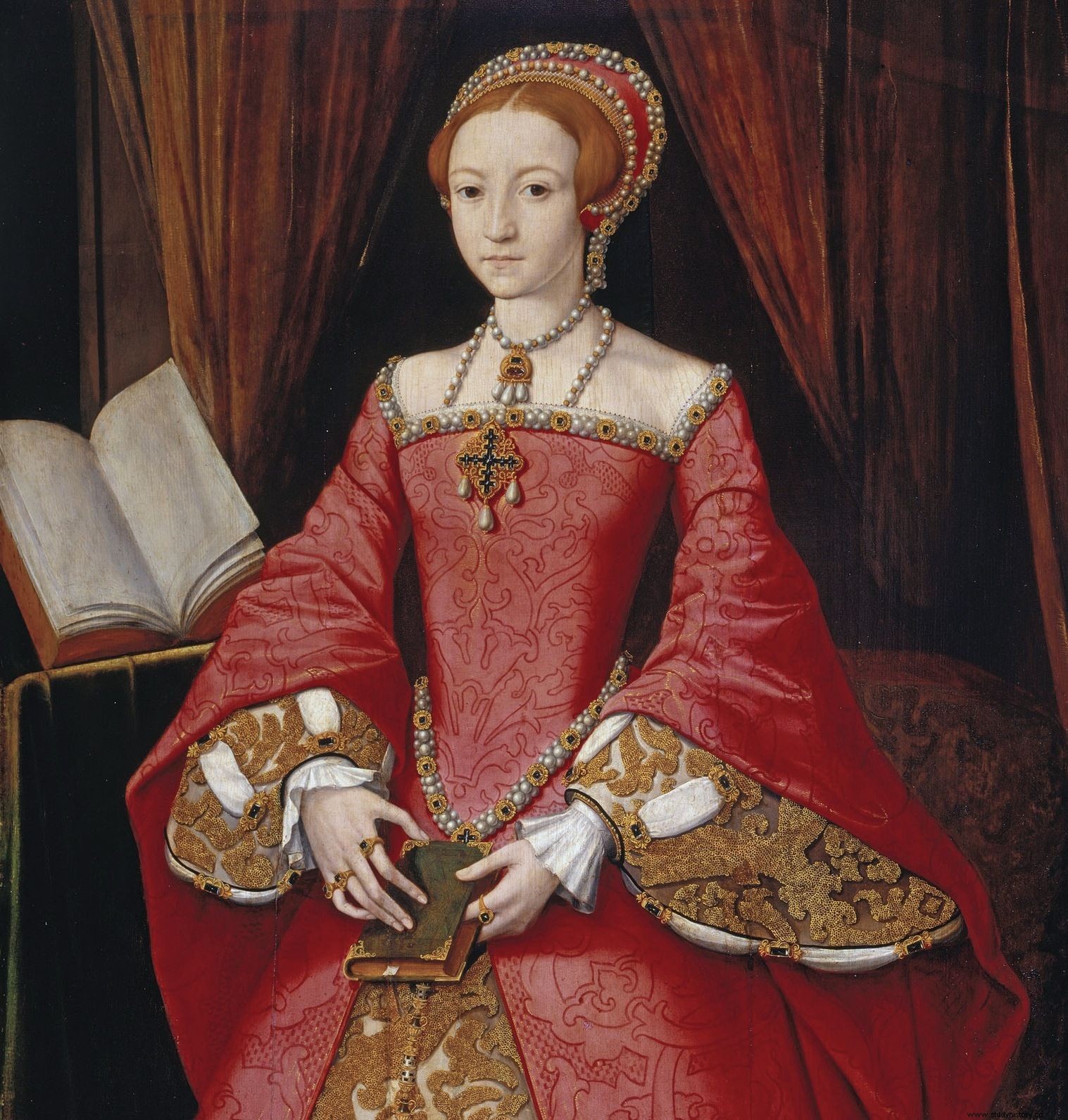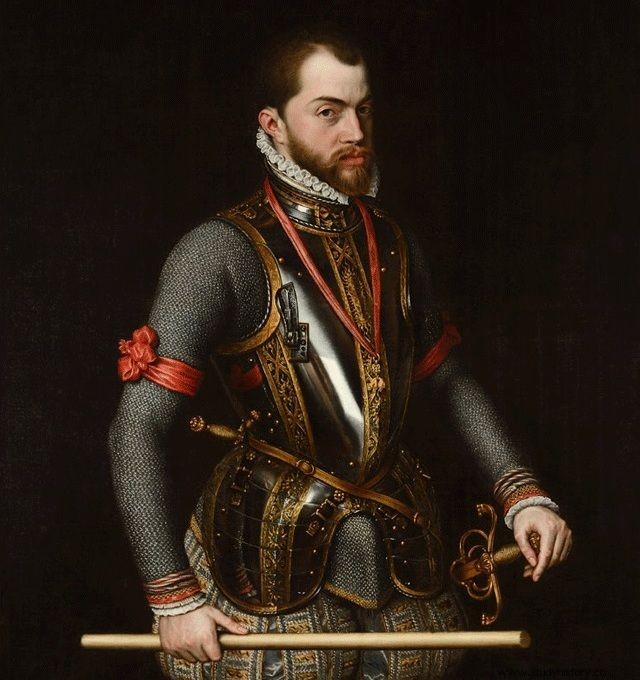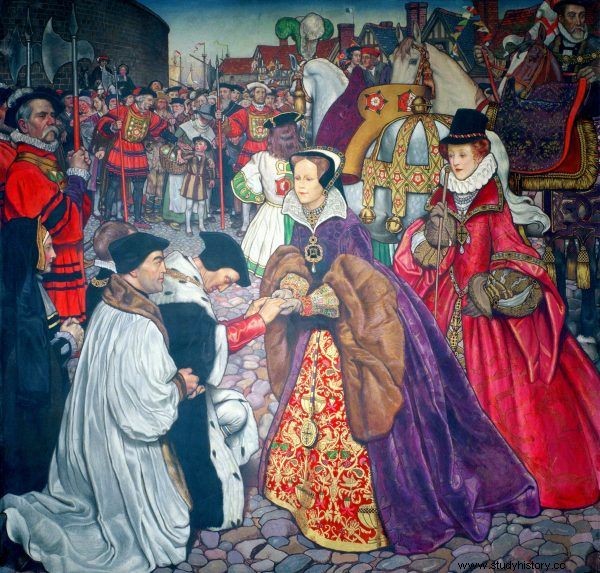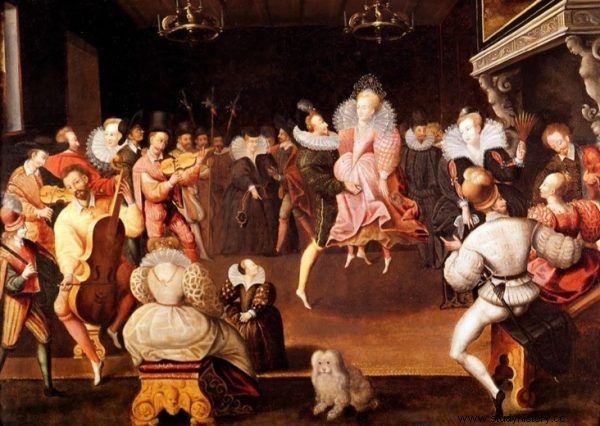The stubble was to be covered with a thick layer of makeup, and Adam's apple was supposed to be covered with crinkled collars. Too long fingers, a penchant for hunting and inexhaustible vitality were to prove conclusively that the most famous ruler of Europe was in fact not a woman at all!
Elizabeth had no reason to be married. Her mother's marriage ended in her bereavement. The father then decapitated his stepmother, Katarzyna Howard. Eight-year-old Elizabeth saw the latter, accused of high treason, escape during the investigation and reach the chapel door, where Henry VIII was listening to the service. Screaming and begging for mercy, she was dragged back for interrogation. Perhaps it was then that the future queen made her decision that marriage was not for her.
On the day of the coronation, when she put the ring on her finger, announcing the marriage with the kingdom, and stubbornly refused to join her hand, it was an incomprehensible decision for many. So there were rumors of physical deformities , problems that prevent intercourse and complete infertility of the queen. Apparently went bald in her early thirties which was explained either by syphilis inherited from the father or by a common condition in ... men.
Princess or prince?
Perhaps the most shocking theory to prove Elizabeth's male gender was the Bisle boy version advocated by the writer Bram Stoker, author of Dracula. According to it, the princess died in the countryside at the age of about eleven. Henryk was fighting in France then, so the people around him tried to save the situation quickly.

Elizabeth I in coronation robes. Many saw in her a deformed being, and maybe even ... a man (source:public domain).
A boy was found who took Elizabeth's place and pretended to be a woman for the rest of his life. This theory was to be proved by the male features of the queen, such as long fingers, a slender figure, a love of hunting and riding, heavy makeup, which was said to hide stubble, and high collars masking Adam's apple.
Can the queen bear children?
But she certainly came into the world as a woman. When she was only seven months old, Henry decided to marry her off to one of the French princes. The arriving MPs were first presented with a baby in a sumptuous outfit and in the majesty of a princess and then ... they were stripped naked so that they could be sure that the reports of the child's defects were false .
During the long years of her reign, the court was buzzing with rumors, the most common of which was about the infertility of the queen . The truth about this was to be guarded by the ruler like an eye in her head. Sir Robert Tyrwhitt wondered in 1549: I believe fervently that between my mistress Ashley [Elżbieta's governess] and the administrator of the royal house [Sir Thomas Parry] there is a secret they will keep until death.

13-year-old Elżbieta… or maybe a boy from Bisle. Because how could a woman have such long fingers and a slender figure? (source:public domain).
But rumors have been circulating since Count de Feria, adviser to Philip II, wrote in 1559, when Elizabeth was only twenty-five:my understanding of having children.
The reason for that was the lack of female genitalia! When Philip, considering the engagement with the English ruler, learned about these rumors, he decided to find out the truth on his own. He managed to bribe Elizabeth's wardrobe clerk. But the maid reported to the suitor that the queen functioned normally as a woman.
A woman's rule against God's law
When Elizabeth was enthroned, her imminent marriage was taken for granted. This was expected of her not only in connection with the need to ensure succession. The queen's marriage was taken for granted as was her coronation. The rule of an unmarried woman was an abomination for many.

King Philip II of Spain Habsburg, widower of his sister Elizabeth I, long sought the hand of the "virgin queen". First, however, he had to make sure if it was really a woman ... A painting by Antonio Moro from 1557 (source:public domain).
It would be better for her and hers if she took a husband who could free her from hardships that are only appropriate for men - wrote Filip Habsburg. In turn, the chancellor and the queen's adviser, William Cecil, asked an ambassador not to discuss with Elizabeth an issue beyond the mental capacity of a woman.
The most emphatic views on this subject, however, were expressed by John Knox in the virulent pamphlet "The First Blow of a Trumpet Against the Monstrous Governance of Women." He claimed that the woman was Satan's gate, a weak, unstable, passive and foolish being. It is an insult to the divine, undermining order and justice when the weak feed the strong, when fools command the wise, in a word, when women rule men.
And although Knox's sharp criticism was directed against Maria Tudor and Maria Stuart, Elizabeth took these words personally and, offended, refused to come to England. In the end, Knox made Elizabeth a miraculous exception and her reign an expression of God's will . Though he still insisted that a man on the throne was the better option.

And that collar again ... 20-year-old Elizabeth accompanying her older sister Maria I on the entrance to London. Oil painting by John Byam Liston Shaw from 1910 (source:public domain).
The surrounding misogyny only strengthened the queen's belief that a wedding would weaken her position. Meanwhile, she did not doubt for a moment that she could rule the state. Reluctance to marry was not so much a matter of personal convictions as of believing that only she could judge what was best for England . Sir Jacob Melville understood this perfectly well when he said:
Your Majesty thinks that if she marries she will only be Queen of England and is now both King and Queen . I know her spirit cannot stand her giver.
A woman, a man or someone in between?
The Dictionary of National Biography said that the queen lived a life of a man, not a woman :she could hunt all day and dance all night, until her knees gave way under strong men . Her teacher from her youth, Roger Ascham, argued that a sixteen-year-old princess had a mind free of female weakness and masculine attention.
E.S. Beesly added in the queen's biography: With endurance to the hardships of the body and strength of mind, she was equal to men . She was bellicose, unrestrained, arrogant and vulgar. She cursed like a cobbler and she didn't mind when others did. For those days, such a woman, in addition not dreaming of a husband and children, simply could not exist.
It seems, however, that these "masculine" qualities can be attributed to the hot Tudor blood. Sir Arthur Keith, professor at the Royal Society of Surgeons, resolved: There is no doubt that Elizabeth was a fully formed woman. We have reports of her breasts and periods .

Elizabeth I "could hunt all day and dance all night until her knees would break under strong men." The Queen while dancing with her favorite Robert Dudley (source:public domain).
She was known to have suffered from what was known as secondary amenorrhea and her doctors said that she rarely has normal bleeding in women . Today, some researchers argue that the ruler may have had an inherited sexual development disorder called androgen insensitivity syndrome. This would explain the menstrual disorder and infertility.
I have the body of a weak and frail woman, but the heart and honor of a king - she said about herself. William Cecil's son Robert, the Queen's Secretary of State, wrote: She was more than a man and I give my word, sometimes less than a woman. Perhaps it was thanks to this that Elizabeth could be both king and queen.
The times of conspiracies, intrigues and spies in the book "Elizabeth I and Robert Dudley. The true story of the Virgin Queen and the man she loved ”:
